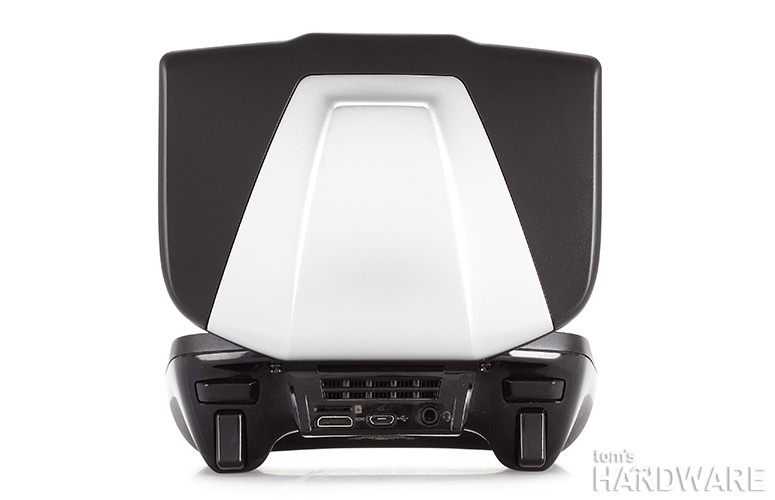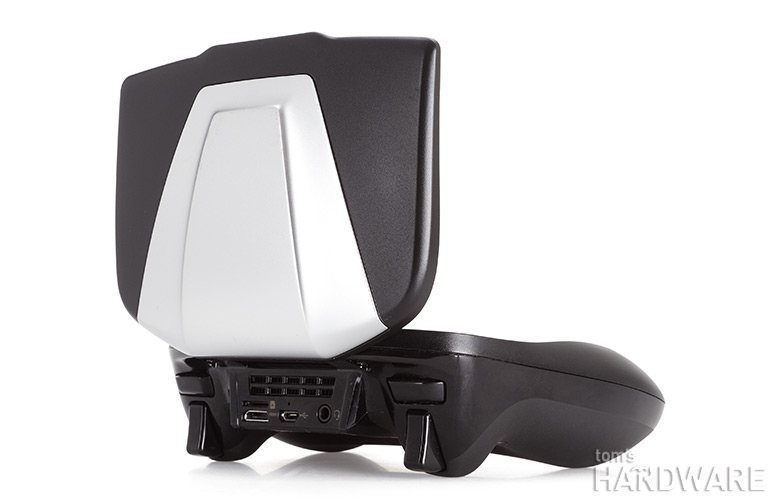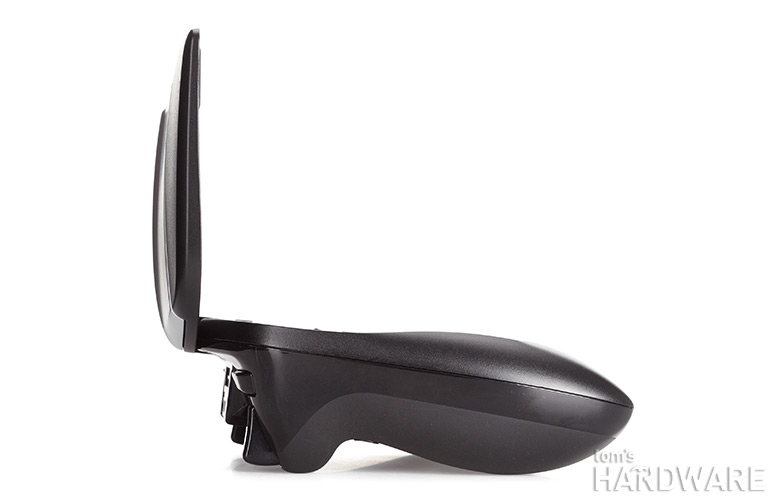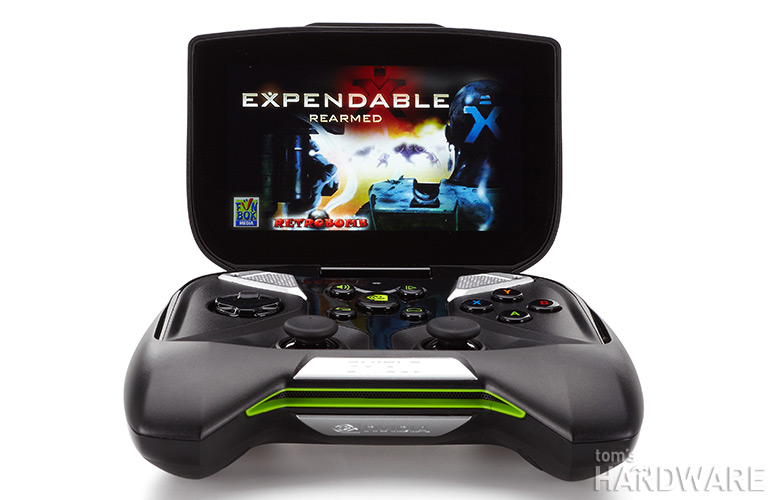Nvidia Shield Review: Tegra 4-Powered Handheld Gaming
We've been playing with Nvidia's Shield handheld for more than a month, but only recently got access to its killer feature: streaming PC game content. Does Nvidia's foray into the hardware world deserve your $300, or is this expensive toy impractical?
Nvidia Shield: The Chassis And Controls
It’s no wonder that Nvidia backed off of Shield’s battery array. The handheld is a heavy piece of hardware. A PlayStation 3 controller weighs 134 g, while our sample rocks the scale at 588 g.
Obviously, Shield has a lot more going on inside. The console is quite a bit more substantial in your hands as result. But its grips share a similar shape, encouraging you to hold on with your middle, ring, and pinky fingers. Pointer fingers wrap around the back, each in easy reach of two trigger buttons per side, while your thumbs hover over the control surfaces.
On the left, you have the directional pad up top with an analog joystick underneath. On the right are four buttons above a second analog joystick. In between are Nvidia’s power/multi-function button, the Android home and back buttons, and a start button. Those take the place of the navigational aids you’d typically find on an Android-based phone, keeping your hands on the mechanical inputs most of the time.
But we’re still using a very computer-like platform, making the lack of a physical keyboard painfully obvious any time you’re prompted for a user name, password, or search keywords. And that’s when you break the game console paradigm, squeeze the handheld between your palms, put four fingers behind the lid, and use your thumbs on Shield’s five-inch touchscreen, knocking out letters through Android’s keyboard. So much of the handheld’s weight is in its base that this is frankly pretty awkward. I just don’t see any better alternative. And I’m at least thankful for a touchscreen. Typing in a password, much less a full search string, using analog joysticks would have been a total pain. Nvidia makes the best of the form factor it chose.
As far as materials go, Shield is really well-built. Most surfaces are a matte black and discourage fingerprints. The glossy sides do get dirty, but wipe down easily. You probably won’t even notice, though. The touchscreen is far more difficult to keep clean. Welcome to a world dominated by touch-oriented interfaces, right? A small lip on the front of the display is used to open the clamshell. You’ll feel resistance all the way back; the screen’s hinge is quite snug and there is no play in any direction.
The Tegra 4 SoC inside Shield is manufactured at 28 nm. However, it still runs hot enough to require active cooling. Green ducting under the Shield badge right up front surrounds an intake. An internal fan pulls air through the front and blows it out a vent in the back, right above the handheld’s I/O. We measured the exhaust at up to 43 degrees Celsius, though there’s so little airflow that it’s hard to imagine the temperature becoming problematic. Even after hours of 3D playback, the Shield’s chassis barely even gets warm.
Controlling Shield
Get Tom's Hardware's best news and in-depth reviews, straight to your inbox.
There are several ways to control and navigate the various applications able to run on Shield. I’d call the d-pad, joysticks, and buttons primary. After all, Shield is shaped in such a way to keep your fingers on the triggers and thumbs over everything else.
The left joystick cycles through on-screen elements one at a time, as does the d-pad. The right joystick controls a mouse cursor. I’m horribly inefficient trying to use that as precisely as a true mouse, though. Meanwhile, the A, B, X, and Y buttons let you select, go back, and open menus.
Really, the physical controls make the most sense once you’re in a game. Tabbing around or pushing the cursor is frustratingly slow when you know you’re also working with a touchscreen. It’s so much easier to just tap the app you want to open or bang away at the letters on Android’s on-screen keyboard. I only wish Shield was more comfortable to hold in that situation, instead of grasping on to the fairly thin lid.
Current page: Nvidia Shield: The Chassis And Controls
Prev Page Nvidia Shield Gives Us Our First Look At Tegra 4 Next Page Touchscreen And Sound-
Hazle impressive, especially PC streaming. but for $300, i'd rather pause the game to take a bathroom break. it's gonna take me a library of good android exclusives for me spend that amount of money, and PvsZ or Angry birds don't cut it.Reply -
beta212 Meh, with the PS4/xbox coming out , and tons of more convenient phones I don't see a market for a tegra4 shield, personally I'm saving my money for a console. The tegra is also too expensive and gimmicky to boot.Reply -
dragonsqrrl When you look purely at the performance and specs $300 unsubsidized isn't all that bad considering the hardware you're getting for the price. The problem to me isn't so much price but the target market. How many people are willing to spend that much on a second or potentially third mobile device meant specifically for gaming and entertainment?Reply -
bryonhowley Looks nice but I can find things better to spend $300 on. In truth I can't see ever streaming my PC games to a 5" screen when I use 3 Asus 27" monitors on my desktop PC. Going from 5760x1080 to 720p does not sound like something I am ready to do. And if I want to game from my recliner I just use my Xbox 360 wireless controller and play the game on my Panasonic 50" 3D Plasma.Reply -
vaughn2k for U$180, I can get a nice Lenovo Phone. For U$ 500, a good Xbox.. not sure if I need a Shield where I could play anywhere..Reply -
slomo4sho Not sure why most of your benchmarks were just between the shield and the Nexus 7. I understand that the Nexus 7 utilizes Tegra 3 but the iPhone 5, Note 2, or some other tertiary figues should have been included to provide a better comparison between this device and other current generation products.Reply
This device feels like a universal Wii U game pad and there is almost zero reason to own one. -
cats_Paw Considering that Oculus rift will cost somewhere around 300 dollars as well, id rather wait for that to spend my cash.Reply
Streaming is nice but if you are close toy our pc why not use the PC itself?
-
shikamaru31789 I'm just not seeing much reason to get one right now, not when I'm saving for the Xbox One and PS4. If it was at a lower price and if it supported AMD GPU's for PC streaming, I might get one. But they also need to get some developers to make some good Android exclusives, not just your typical mobile time wasters and ports of older console/PC titles, but some actuallAAA exclusives that are optimized for Tegra 4.Reply






